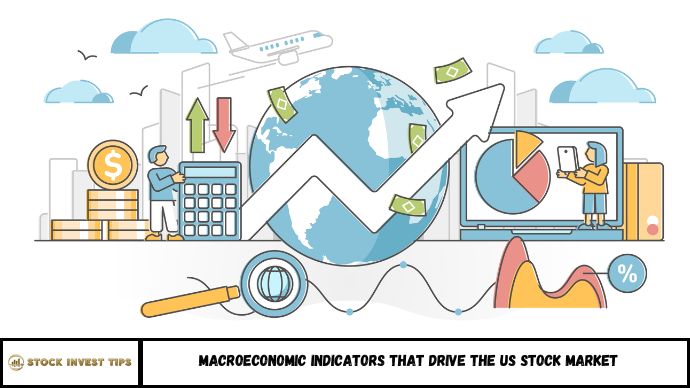Why do stock prices swing wildly after a jobs report or inflation update? Because macroeconomic indicators are powerful signals that shape investor behavior, market forecasts, and government policy.
Whether you’re an investor, analyst, or business owner, understanding these indicators is essential. In this article, we’ll break down the most influential macroeconomic metrics, explain how they impact the stock market, and show you how to interpret them effectively
Macroeconomic indicators like GDP, inflation, and interest rates directly impact the US stock market. Investors rely on these signals to assess economic health, predict earnings, and anticipate Federal Reserve actions. This guide explains key indicators, their market influence, and how to use them to make smarter investment decisions.
A company’s stock price isn’t influenced solely by its profits or debt. In reality, broader economic indicators play a major role in shaping overall market sentiment—often impacting individual stock performance just as much as company-specific factors.
The good news? You don’t need a degree in economics to grasp how these indicators affect the market—or your portfolio. Below, we’ll break down some of the most important macroeconomic signals every investor should understand.
What Are Macroeconomic Indicators?
Macroeconomic indicators are data points that reflect the overall health and direction of an economy. The U.S. government and independent agencies release these stats regularly, providing insights into trends like growth, inflation, employment, and consumer behavior.
Why They Matter to Stock Market Performance
Investors use these indicators to:
- Forecast corporate earnings
- Gauge consumer spending
- Anticipate monetary policy decisions
- Assess risk and valuation
Markets tend to react quickly to surprises in macro data—either rallying or retreating depending on whether the news is better or worse than expected.
Key Macroeconomic Indicators That Move the Market
1. Gross Domestic Product (GDP)
GDP measures the total value of goods and services produced within the U.S.
- Impact: Strong GDP growth typically boosts investor confidence and stock prices.
- Data Release: Quarterly, by the Bureau of Economic Analysis (BEA).
- Recent Stat: U.S. GDP grew at an annualized rate of 2.3% in Q1 2025.
2. Inflation Rate (CPI and PPI)
- Consumer Price Index (CPI) measures retail price changes.
- Producer Price Index (PPI) tracks wholesale prices.
- Impact: Rising inflation can lead to higher interest rates, which usually negatively affect stocks, especially growth sectors.
- Recent Stat: The CPI rose 3.1% year-over-year in May 2025 (U.S. Bureau of Labor Statistics).
3. Interest Rates (Federal Funds Rate)
Set by the Federal Reserve, this is the benchmark for lending rates.
- Impact: Higher rates make borrowing more expensive, slowing growth and reducing corporate profits. Conversely, lower rates boost spending and stock valuations.
- Current Rate: As of June 2025, the Fed Funds Rate stands at 5.25%.
4. Employment Data (Nonfarm Payrolls & Unemployment Rate)
- Indicates job growth and labor market strength.
- Impact: A strong labor market can support higher consumer spending but may raise inflation concerns.
- Recent Stat: In May 2025, the U.S. added 275,000 jobs; unemployment remained at 3.8%.
5. Consumer Confidence Index (CCI)
Reflects how optimistic or pessimistic consumers are about the economy.
- Impact: Rising consumer confidence signals increased spending, which supports business revenue and stock performance.
- Current Level: CCI reached 105.6 in June 2025, according to The Conference Board.
6. Retail Sales
Shows the total receipts of retail stores.
- Impact: Strong sales data suggest healthy consumer demand, a key driver of GDP.
- Recent Trend: Retail sales grew 0.7% in May 2025, exceeding expectations.
How Analysts and Investors Use These Indicators
Market Timing
Sudden changes in indicators (e.g., surprise inflation spikes) can signal entry or exit points.
Sector Rotation
Some sectors outperform under certain conditions:
- Rising inflation favors energy and commodities.
- Falling interest rates benefit tech and real estate.
Policy Prediction
By analyzing indicators, investors try to anticipate Federal Reserve moves, which directly affect market liquidity and volatility.
Best Practices for Monitoring Macroeconomic Indicators
- Use an Economic Calendar: Track release dates on platforms like Investing.com or Trading Economics.
- Compare vs. Expectations: Market reactions depend more on the difference between forecast and actual data than the numbers themselves.
- Look at Trends, Not One-Offs: Single reports can be noisy. Three-month averages often reveal the real story.
Frequently Asked Questions (FAQ)
1. Which macroeconomic indicator affects the stock market the most?
Interest rates often have the most immediate and broad impact, especially when changed by the Federal Reserve.
2. How do inflation reports affect the stock market?
Rising inflation usually leads to interest rate hikes, which can depress stock prices.
3. Are macroeconomic indicators relevant for long-term investors?
Yes. Long-term trends in GDP, inflation, and employment guide strategic asset allocation.
4. How often are economic indicators released?
Most key indicators are released monthly or quarterly by government agencies.
5. Where can I find trustworthy macroeconomic data?
Use official sources like the U.S. Bureau of Labor Statistics, BEA, or Federal Reserve.
6. Do macroeconomic indicators affect all stocks equally?
No. Some sectors react more to specific data—for example, banking reacts strongly to interest rate changes.
Conclusion
The stock market doesn’t move randomly—it reacts to real economic signals. By understanding macroeconomic indicators, you can better predict market movements, adjust your strategy, and avoid emotional decision-making.
Whether you’re a seasoned investor or a curious beginner, keeping an eye on the economy’s dashboard will make you a more informed—and successful—market participant.

